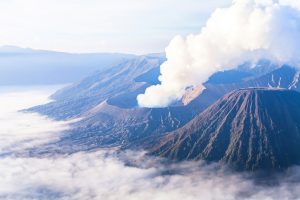Indonesia, a country famously made up of some 17,000 islands, is known for many things: fried rice, friendly people, Komodo dragons, Bintang beer, toothsome satay, emerald rice terraces, stunning waterfalls, and plenty of sunshine.
It is also famous for its volcanoes, and scaling one of the country’s famed peaks is the highlight of a trip for many visitors, from Mount Rinjani on the island of Lombok, to Mount Bromo in East Java, to Mount Agung in Bali.
As British travel writer Tim Hannigan wrote in a 2012 satirical article for New Matilda entitled “How To Write About Indonesia”: There must be a volcano” and the “volcano is a symbol of how Indonesia is exotic, mysterious, and threatening.”
With that in mind, it was disheartening, but perhaps not completely surprising, to hear that some 23 people died on the slopes of Mount Marapi in West Sumatra on December 3 after the active volcano erupted, spewing an ash cloud 3,000 meters into the air.
Incidentally, Mount Marapi in West Sumatra is not to be confused with Mount Merapi in Central Java and another Mount Merapi in East Java. “Merapi” in Indonesian means “of fire,” which perhaps accounts for the number of volcanoes so-named, but which also caused confusion for a number of media outlets initially reporting on the incident at Mount Marapi.
The fact that it is easy to confuse Indonesia’s volcanoes is understandable when you consider how many there are. The country has some 127 active volcanoes that erupt periodically, sometimes resulting in the loss of life, destroying the surrounding land and killing livestock.
In December 2021, Mount Semeru on the island of Java erupted, killing more than 30 people and displacing 3,000. In 2018, Anak Krakatau, between the islands of Java and Sumatra, erupted causing a tsunami that killed hundreds. Mount Marapi has also had its share of incidents including this latest one and an eruption in 1979 killed 60 people.
While volcanoes are, by their very nature, difficult to predict, could more be done to make them safer?
One of the issues this time with Mount Marapi was whether an early warning system had sounded the alarm that an eruption was imminent, which appears not to have been the case. However, officials said that hikers had been warned not to climb to the peak of the volcano and to keep some three kilometers away from the crater, which is standard practice around the country’s active mountains.
In North Sumatra, Mount Sinabung in the Karo Highlands erupts with regular frequency and has claimed the lives of locals and hikers alike. In 2014, 16 people were killed when the mountain erupted and seven people died in 2016 after being caught in a pyroclastic flow. As a result, Mount Sinabung also has restrictions around its crater, and the government has enacted a similar seven kilometer “red zone” designed to keep people safe.
Despite that, the issue of venturing close to Indonesia’s fire mountains doesn’t just involve hikers and tourists. In the case of mighty Mount Sinabung, many locals still risk entering the “red zone” to tend to their coffee plantations which sit close to the volcano’s slopes.
Much of the land that surrounds Mount Sinabung, and many other peaks in Indonesia, has been handed down through generations, meaning that people are ill-inclined to desert it, even if the consequences may be dire. While the government has been able to build new homes for many locals outside the “red zone” around Sinabung, it is challenging to transplant coffee plantations elsewhere. When people live off their land, they have little choice but to stay close to it, even if it sits in the shadow of a volcano.
Back to the case of Mount Marapi, it will be interesting to see whether an investigation into the incident reveals any negligent activity, such as local guides leading hikers too close to the crater despite the known risks associated with doing so, and whether any further action will be taken to prevent hikers from venturing onto the mountain at all.
But closing down Indonesia’s famous peaks entirely is a challenging decision to make.
Many tourists, both domestic and international, want to experience the majesty of the country’s volcanoes first-hand and, if they are not allowed anywhere near them, this could present an issue for Indonesia’s tourist industry and its reputation as the land of the fiery peaks.
As Hannigan wrote for New Matilda, Indonesia’s volcanoes are the stuff of legend, yet also intrinsically threatening.
Should they be off-limits completely, or is there a way to make them safer?

































